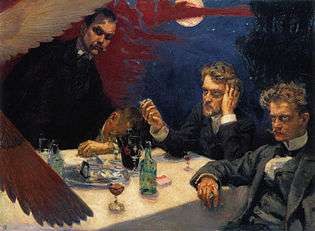Symphony No. 1 (Sibelius)
| Symphony No. 1 | |
|---|---|
| by Jean Sibelius | |
 The 1894 group portrait Symposium, with (from l. to r.) Akseli Gallen-Kallela (the artist), the composer Oskar Merikanto, Robert Kajanus and Sibelius. Kajanus conducted the first performance of the revised Symphony in 1900, which launched Sibelius's international career. |
The Symphony No. 1 in E minor, Op. 39, by Jean Sibelius is a symphony started in 1898, and finished in early 1899, when Sibelius was 33. The work was first performed on 26 April 1899 by the Helsinki Philharmonic Orchestra, conducted by the composer, in an original version which has not survived. After the premiere, Sibelius made some revisions, resulting in the version performed today. The revised version was completed in the spring and summer of 1900, and was first performed in Berlin by the Helsinki Philharmonic, conducted by Robert Kajanus on 18 July 1900.[1]
The symphony is characterized by its use of string and woodwind solos; the first movement opens with a long and discursive clarinet solo over a timpani roll; (this idea returns at the start of the fourth movement, fortissimo in the strings, with wind and brass chordal accompaniment), and subsequent movements include violin, viola, and cello solos.
Most performances of the work last between 35 and 40 minutes. Many conductors choose to slacken the speeds suggested by Sibelius's metronome markings, particularly in the fast part (allegro energico) of the first movement. Because of this, many versions of the symphony are about 38–40 minutes long (the publishers suggest the duration is 40 minutes[2]). In Osmo Vänskä's recording of the work, released in 1997, the first movement is played at the metronome mark suggested by Sibelius and takes 9:42 (compared with the 10½–11½ minute duration of most other recordings).
Instrumentation
2 flutes (both doubling on piccolo), 2 oboes, 2 clarinets (1st and 4th movements in A, 2nd and 3rd in B♭), 2 bassoons, 4 horns, 3 trumpets, 3 trombones, tuba, timpani, triangle, bass drum, cymbals, harp, and strings
Movements
Like most symphonies, it is in four movements:
- Andante, ma non troppo – Allegro energico (dotted half note = 108 MM) (in E minor & sonata form with introduction)
- Andante (ma non troppo lento) (half note = 54 MM) (in E-flat major & ternary form)
- Scherzo: Allegro (dotted half note = 108 MM) (in C major & sonata form with augmented development)
- Finale (Quasi una fantasia): Andante – Allegro molto – Andante assai – Allegro molto come prima – Andante (ma non troppo) (in E minor & sonata form with introduction)
The first recording was made by Robert Kajanus with the London Symphony Orchestra for the HMV label in May 1930.
References
- ↑ David Ewen, Music for the Millions – The Encyclopedia of Musical Masterpieces (READ Books, 2007) p533
- ↑ MusicSalesClassical.com's "suggestion" of the tempo
External links
- Symphony No.1, Op.39: Scores at the International Music Score Library Project
- Article
- Flying Inkpot Review
- WAV and MP3 clips from each movement
- First Recording (1930) , conducted by Robert Kajanus.